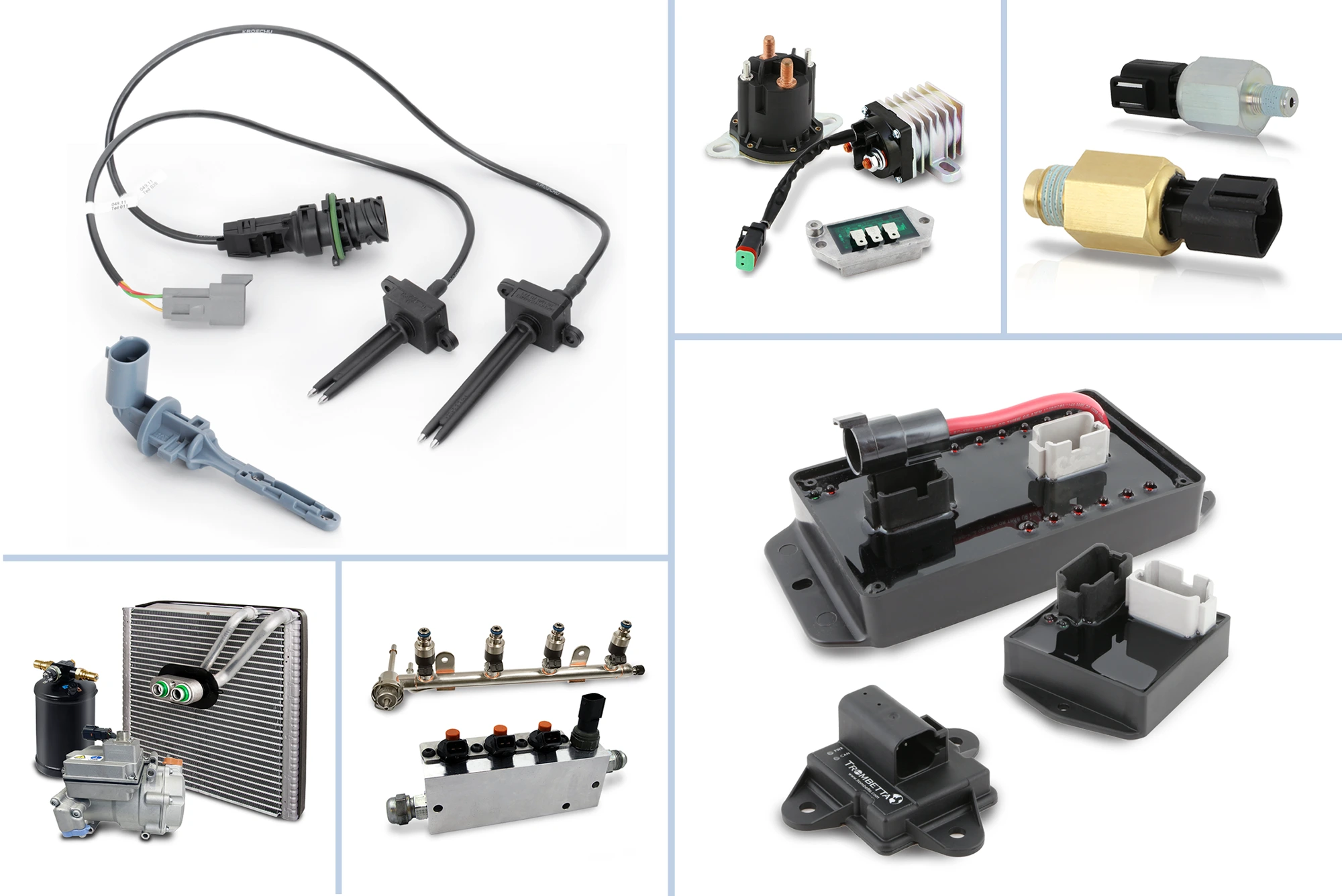January 22, 2024 / Training
A Closer Look: ABS Sensors
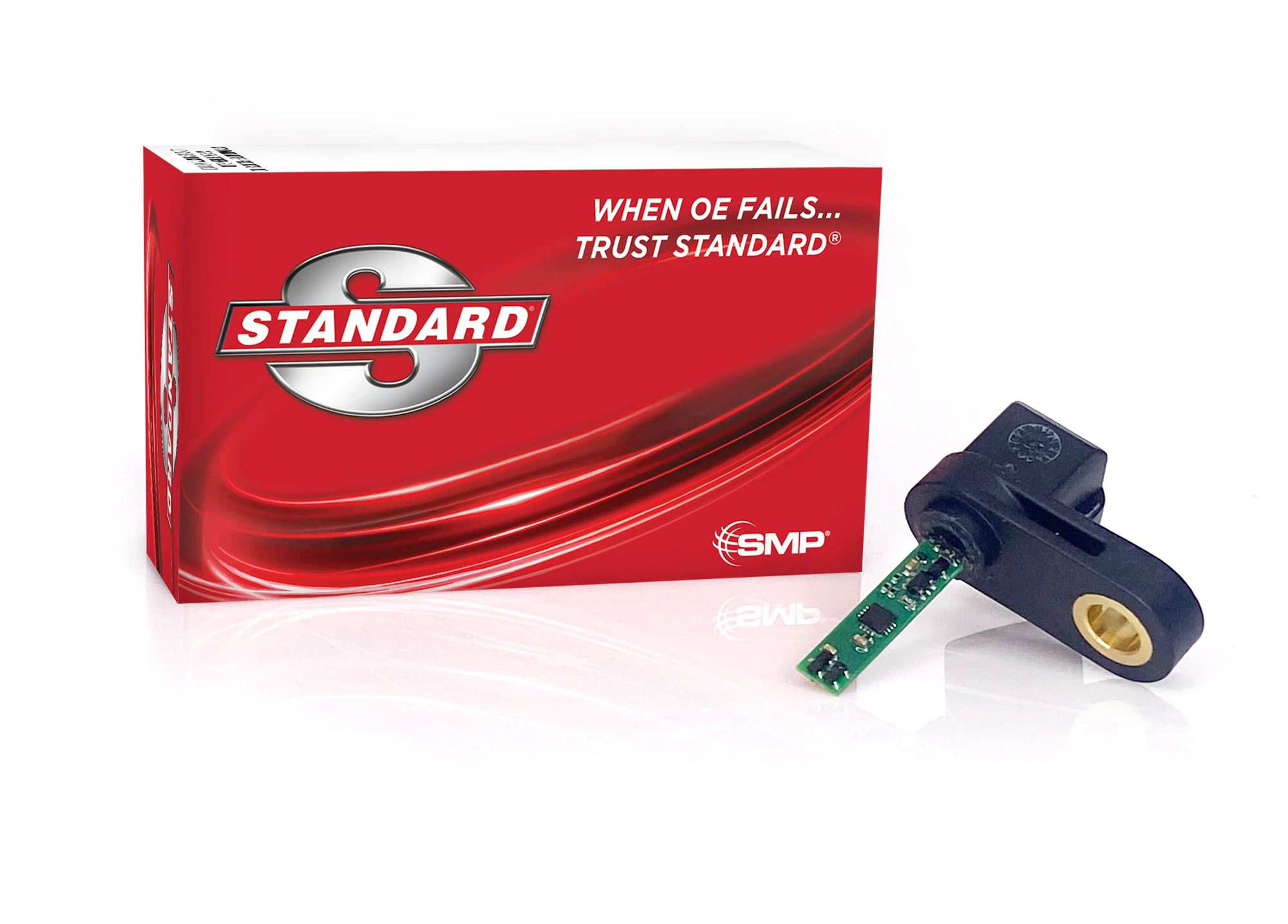
ABS Unwrapped
Anti-lock Braking Systems are intended to do exactly as the name portrays – prevent a vehicle’s wheels from locking up during a braking event. If any of the wheels lock up, the driver has less control of the vehicle and is more prone to an accident. By releasing some brake pressure to the locked-up wheel, the stopping distance will be increased, but the driver will be able to maintain control to hopefully avoid a collision. Prior to ABS, drivers were taught to pump the brake pedal when attempting to stop suddenly, or when stopping on gravel, ice, or loose pavement. Now, the ABS system does that for them.
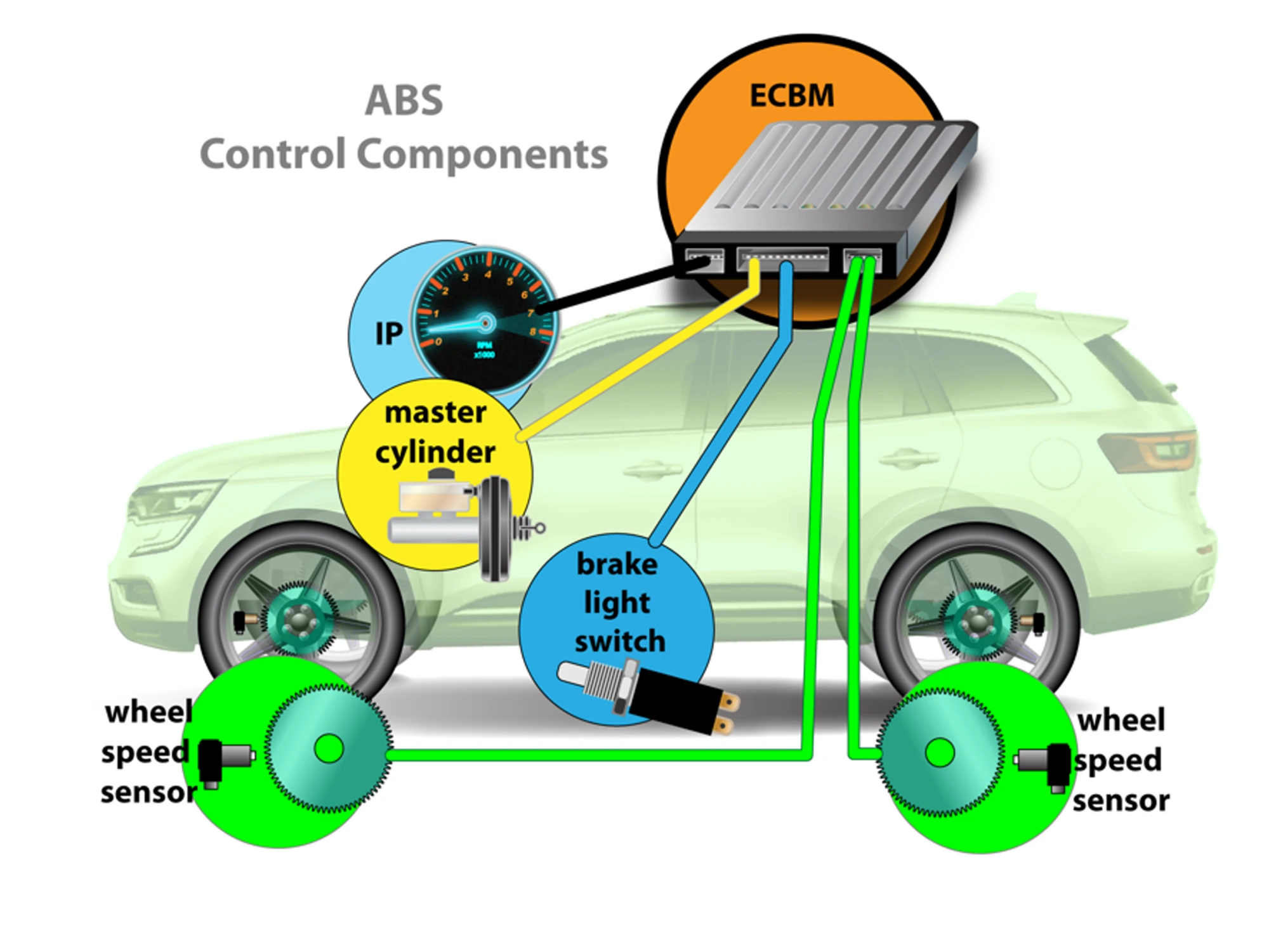
ABS is primarily concerned with negative wheel slip, but it also monitors, and many times compensates, for any variation in wheel speeds. The major components to every ABS system are wheel speed sensors, brake switches, brake master cylinders, EBCM, and hydraulic assemblies containing the pump motor, accumulator, valves, and solenoids.
Passive vs. Active
The heart of ABS is the wheel speed sensor. To date, there are two categories of wheel speed sensors: passive and active. The first generation of wheel speed sensors were passive. These are variable reluctance (VR) sensors, and are essentially a magnet within a coil of wire. Signals are generated by rotating a metal reluctor past the sensor. As the cogs approach the sensor, the magnetic field expands, and when the cog moves away from the sensor, the magnetic field collapses. The expanding and contracting magnetic field induces an AC voltage, which is then recognized by the EBCM as a speed signal, based on the frequency of the changes.
Signal strength is dependent upon speed, so these sensors are not considered effective at low speeds. This is why they are not used in stability control systems. Expected resistance of the sensor should typically be somewhere between 1,000 and 2,500 Ohms, which can be tested with an Ohm meter. The resistance spec will often be found imbedded in a testing procedure instead of within specs. In addition, air gap between the sensor and the tone ring is critical.
Many vehicles now use active speed sensors. These sensors were first used shortly after 2000, but some manufacturers didn’t use them until 2010. Different types of active speed sensors include Hall Effect or Magneto Resistive sensors.
Hall Effect sensors are commonly used in automotive applications for measuring the speed of a rotating object, such as a crankshaft or camshaft. They have recently gained popularity as wheel speed sensors due to their accuracy across the entire speed range, along with their resistance to dirt, mud, water, and rust. Unlike magnetic generator-type sensors, which produce an AC sine wave, Hall sensors produce an accurate square wave signal.
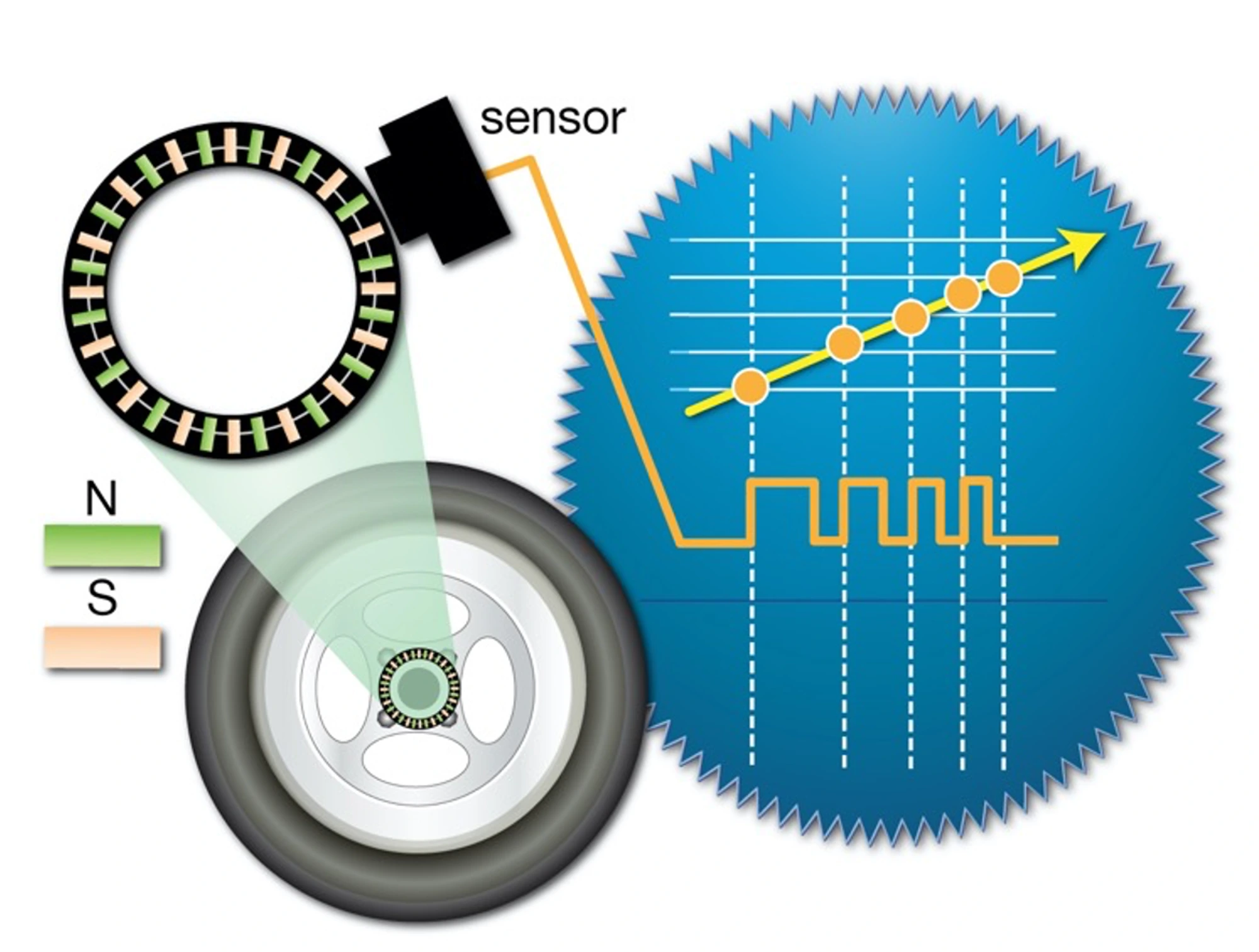
The Hall Effect sensor is constructed of a stationary permanent magnet and semiconductor Hall Effect chip that are mounted next to each other, separated by an air gap. A metal rotor consisting of windows and blades is mounted to a shaft, such as the wheel bearing or axle shaft, and arranged so that during rotation, the windows and tabs pass the permanent magnet and semiconductor Hall chip. This effectively shields and exposes the Hall chip to the permanent magnet’s field respective to whether a tab or window is passing though the Hall sensor. When the shutter blade is blocking the chip from the magnetic force, a voltage is produced from the Hall Effect sensor. When the chip is exposed to the magnet through a window, the voltage collapses.
A Magneto Resistive (MRE) sensor is very similar to a VR sensor with Hall Effect-like properties. An MRE sensor requires a power source and produces a frequency-modulated signal. This is a more accurate way to analyze rotational and linear position by measuring the direction of the field lines, not the magnetic strength. These sensors are becoming increasingly popular in automotive applications due to their accuracy and adaptability. Magneto Resistive sensors are being used in ABS, CMP, and CKP sensors.
To test these sensors, the technician should verify that there is power present on one of the wires. The other wire will typically output a square wave, which will be frequency-modulated. A scope is still the best tool for watching the square wave, but a DVOM can also be used to test for a signal. It is important to search service information to find the operating characteristics of the specific sensor being tested.
Choosing the Best Parts for the Job
Active-style ABS sensors have been around for over a decade now, but how do you know that the sensor you pulled out of the box will perform on your customer’s car in all situations? During extensive engineering and vehicle test center research, Standard® recognized that many aftermarket competitors missed important details on their newer ABS sensors. For example, several modern vehicles feature a signature on the sensor output signal that indicates reverse wheel rotation. In Standard’s testing of 48 different sensors, it was discovered that many aftermarket sensors did not include this special indicator, which can negatively affect vehicle safety systems like Hill Hold Assist and Electronic Stability Control. Standard® ABS Sensors, like ALS684, are designed and manufactured using microsensors to produce unique forward and reverse signals, ensuring that the part you install on your customer’s vehicle will keep the safety systems operating as designed.
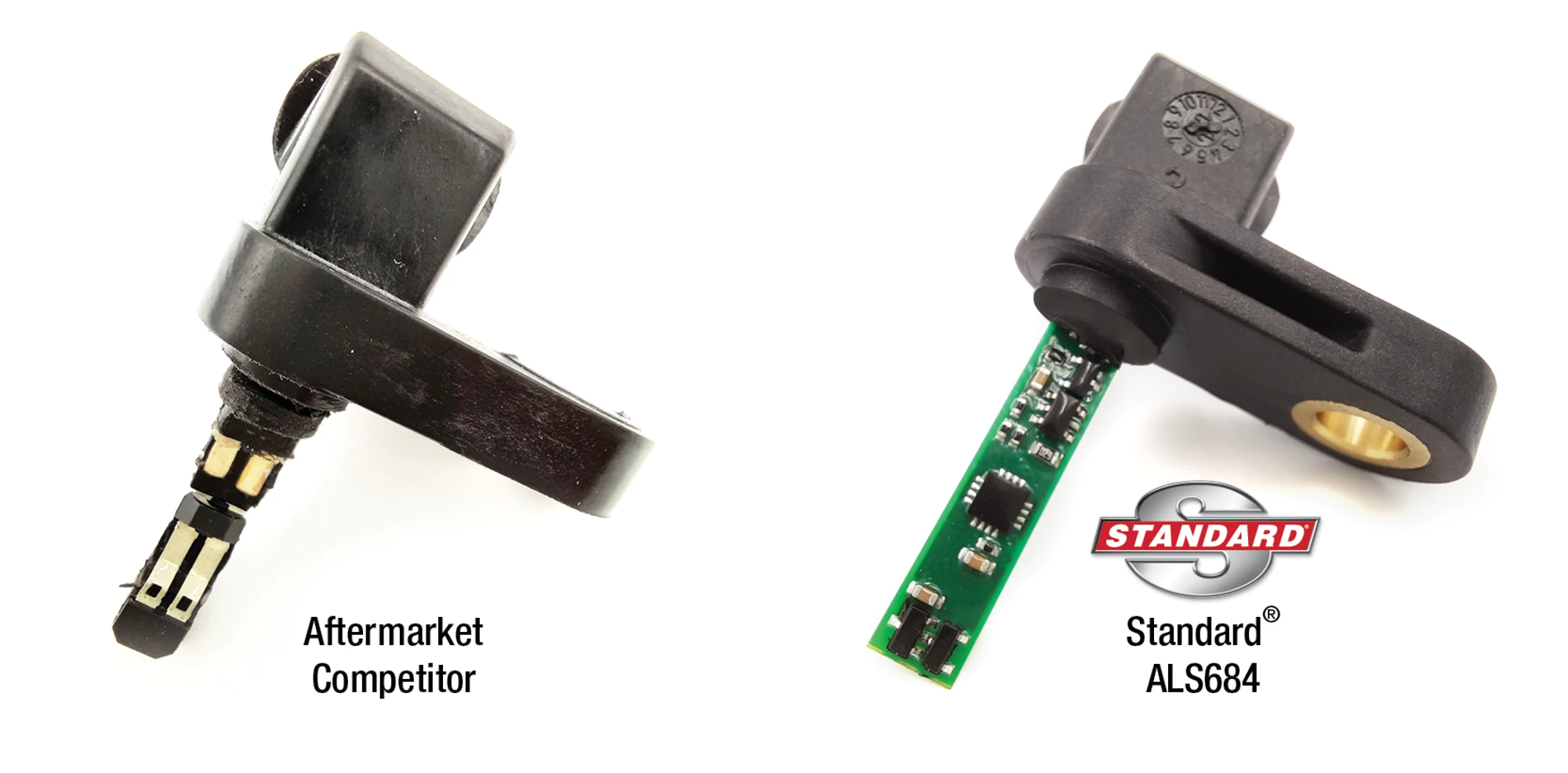
Standard® also knows that rigorous testing means a more reliable sensor. That’s why Standard® performs extensive testing in the laboratory and in real-life situations. This testing includes measuring, evaluating, and comparing shaft speed versus delta voltage, output voltage and variation to OE, magnetic field strength and air gap, output wave form, pulse width, and more.
Standard® ABS Sensors are available for import and domestic vehicles with electric, hybrid, gas, and diesel powertrains. With more than 2,600 part numbers, Standard® has you covered. Each ABS Sensor is engineered to integrate with the vehicle’s electronic safety systems and perform as the vehicle manufacturer intended, in all situations. Standard also includes the applicable grommets and wire clips, or protective wire harness sleeves, making it easier to install right out of the box.
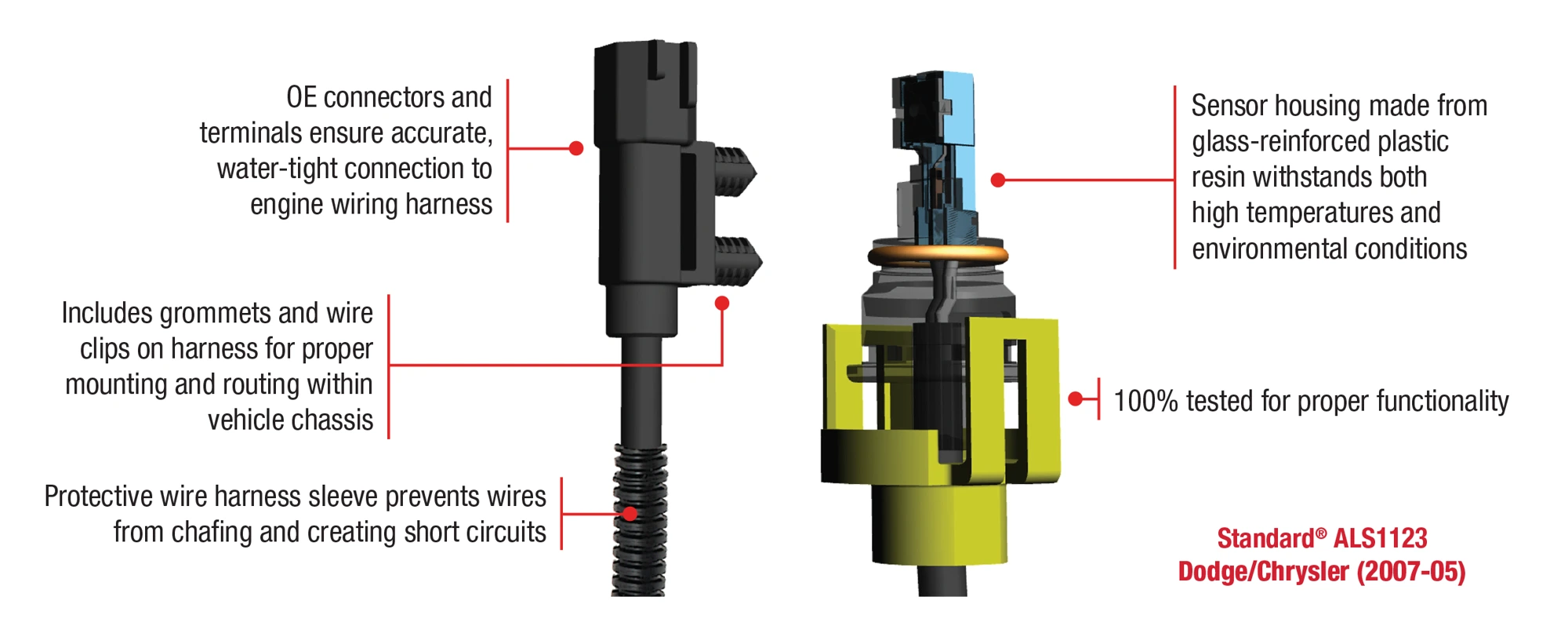
For more information on Standard® ABS Sensors and for helpful installation tips, search “ABS” on the StandardBrand YouTube channel or visit StandardBrand.com
March 01, 2024 / Training
Why Pentastar Oil Filter Housings Fail
In service since 2011, the Chrysler Pentastar 3.6L engine has powered more than 10 million of the most popular vehicles on the road. These Pentastar engines are equipped with oil filter housings, which contain the oil filter, sensors, and a heat exchanger to help cool the oil. The oil filter housings on the Pentastar V6 engine have become known for their high failure rates. These failures have mistakenly been attributed the idea that the housings can warp due to heat, but this has been proven false. So, why do these units typically leak?
August 15, 2022 / Training
Variable Valve Timing (VVT) Repair Tips
Variable Valve Timing (VVT) or Variable Cam Timing (VCT) is common on most newer engines. These systems are designed to reduce emissions and maximize engine performance and fuel economy. Here's some background on VVT and a few tips for dealing with issues that come up.
August 22, 2022 / Training
Variable Valve Timing (VVT) Operation
Variable Valve Timing (VVT) systems help reduce emissions and maximize engine performance and fuel economy. The VVT Solenoid (Oil Control Valve) meters the oil flow to control the actuation of the VVT Sprocket (Actuator or Phaser). The VVT Sprocket mechanically shifts the position of the camshaft. Here are a few tips for testing.
August 08, 2022 / Training
Turbocharger Diagnosis Tips
Turbocharged engines are becoming more popular, as vehicle manufacturers look to increase fuel efficiency, maintain performance and reduce emissions. Symptoms of a malfunctioning turbocharger include loss of power, excess smoke, high fuel consumption, overheating, high exhaust temperature and oil leaks from the turbo. Here are a few important diagnostic and repair tips to keep in mind.
August 12, 2022 / Training
Tire Pressure Monitoring System (TPMS) Repair Tips
The Tire Pressure Monitoring System (TPMS) is a safety device that measures, identifies and warns you when one or more of your tires is significantly under-inflated. Standard® and Intermotor® are committed to helping technicians with TPMS repairs, whether it’s offering OE-Match TPMS sensors or providing repair tips from our team of ASE-certified master technicians. Here are a few TPMS repair tips.
August 05, 2022 / Training
Mass Air Flow (MAF) Sensor FAQs
The Mass Air Flow (MAF) sensor is a key component of the engine’s fueling strategy. It is crucial that the MAF sensor reports with 100% accuracy to ensure peak performance, fuel economy and reduced emissions. Here are some helpful tips such as how and when to replace them and steps to extend their longevity.
August 19, 2022 / Training
Ignition Coil Operation
Coil-on-plug assemblies are designed to convert a low voltage (primary side) to a high voltage (secondary side) to fire the spark plugs. They perform the functions of both the ignition coil, which creates the spark energy, and the spark plug wire set, which delivers the high-voltage energy to the spark plug. Today's coil-on-plug assemblies come in a variety of physical and wiring configurations.
August 01, 2022 / Training
Diesel Engine Repair Tips
Diesel Engines have become more popular thanks to a steady string of advancements. New engine designs, noise and vibration-damping technologies, and improvements like electronic engine control have spawned a new generation of engines that are more powerful and fuel efficient than similar-size gasoline engines. Learn more about today's diesel engines with these repair tips from our team of ASE-certified master technicians.
January 01, 2023 / Training
A Closer Look: Variable Valve Timing
In an effort to increase fuel efficiency and elevate performance across today’s vehicles, nearly every manufacturer has equipped new vehicles with Variable Valve Timing (VVT) technology, also known as Variable Cam Timing (VCT).
January 05, 2024 / Training
A Closer Look: Turbochargers
Turbocharger Opportunities: In an effort to increase fuel efficiency, maintain performance, and reduce emissions, vehicle manufacturers are adding turbocharged engines to their lineups at a significant rate. Over the next five years, the turbo service market will continue to experience substantial growth.
September 19, 2022 / Training
A Closer Look: Turbocharger Operation and Installation
Turbochargers consist of just three major internal components: the turbine, the compressor and the bearing system that supports the turbine shaft. In an effort to increase fuel efficiency, maintain performance and reduce emissions, vehicle manufacturers are adding turbocharged engines to their lineups at a significant rate.
September 16, 2022 / Training
A Closer Look: Tire Pressure Monitoring Systems (TPMS) Operation
The Tire Pressure Monitoring Systems (TPMS) is a valid safety device that has been mandated for years. TPMS introduced a lot of new terminology – initiate, program, activate, clone, protocol and relearn. This safety system, a prime service opportunity, warns drivers of issues with their tires and protects motorists from potential danger.
January 15, 2024 / Training
A Closer Look: Servicing Electric and Hybrid Vehicles
Hybrid vehicles have been sold in the U.S. for over 20 years. As hybrids continue to grow in popularity, and as fully electric vehicles have entered the market in the past several years, they have brought with them numerous service opportunities for aftermarket repair facilities. Whether shops dive in and get involved with replacing batteries, inverters, or other high-voltage components, or they stick to light-duty servicing, there is plenty of work to go around.
January 08, 2024 / Training
A Closer Look: Ignition Coils
Engine misfires, rough idle, a decrease in power under acceleration, poor fuel economy, and a check engine light are all signs of an ignition coil that has failed. OE coils are known for their high failure rates. Read along for more information on ignition coils, how to diagnose a failed one, and why an original equipment manufacturer’s coil may not be the best replacement choice.
January 12, 2024 / Training
A Closer Look: Gasoline Direct Injection (GDI)
Gasoline direct injection (GDI) is used on most new vehicles and requires a different approach to diagnosis and service. GDI technology has been an integral part of helping to improve fuel economy while reducing emissions and can be found in more than half of the U.S. fleet. In fact, the use of GDI engines has grown by over 600% since 2010. This means that in the next five years, 42 million more vehicles with GDI will enter the Aftermarket “Sweet Spot” of 6-12 years old, during which their injectors and related parts may need to be serviced or replaced. While GDI systems have proved effective, these systems encounter specific failures and require an understanding of how they work and how to test them when they set a code.
September 12, 2022 / Training
A Closer Look: Electronic Throttle Bodies and Control Systems
Electronic Throttle Control (ETC) systems are responsible for improving fuel economy, reducing emissions, protecting powertrain components and providing an overall better driving experience. Most vehicles on the road today use ETC. It is important for technicians to understand the principles of the system before delving into system specifics.
January 29, 2024 / Training
A Closer Look: Electronic Throttle Bodies
A shop’s reputation is affected by things like accuracy of diagnosis, quality of the repair, and friendly service. Equally as important is the quality of the parts installed. If the shop does everything right, and the part fails, the customer will ultimately be upset with the shop. When a new part fails, the customer is inconvenienced again, and begins to lose faith with the shop that performed the work. This ultimately begs the question–why take a chance with inferior parts?
September 09, 2022 / Training
A Closer Look: Blower Motor Resistor Operation
Blower Motor Resistors (BMR) control the electrical current flowing from the fan switch to the blower fan, which allows the motorist to set the fan at different speeds. The fan speed can be changed by switching the blower resistor resistance mechanically, using a rotating lever, or electronically, by the air conditioning system.
September 05, 2022 / Training
A Closer Look: Anti-Lock Braking (ABS) System Operation
The Anti-Lock Braking System (ABS) is concerned with monitoring and controlling wheel slip, which helps maintain vehicle control. The major components of every ABS system are: wheel speed sensors, brake switch, brake master cylinder, EBCM and hydraulic assembly containing the pump motor, accumulator, valves and solenoids.
